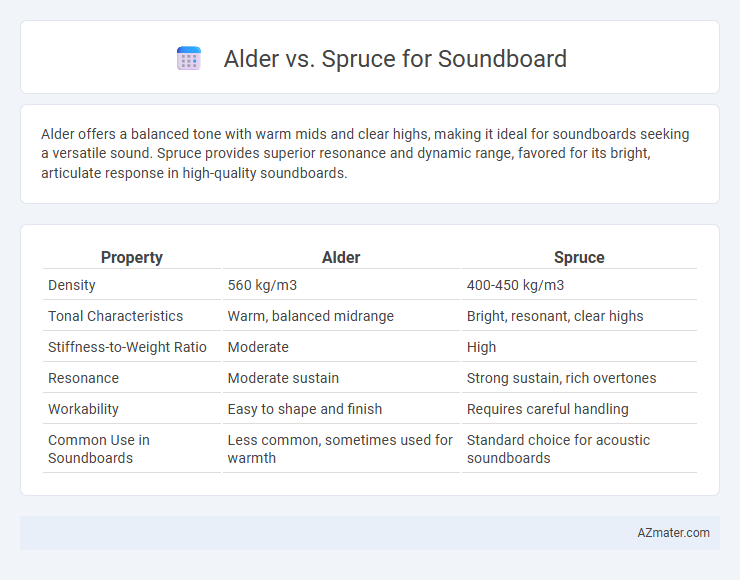Alder offers a balanced tone with warm mids and clear highs, making it ideal for soundboards seeking a versatile sound. Spruce provides superior resonance and dynamic range, favored for its bright, articulate response in high-quality soundboards.
Table of Comparison
| Property | Alder | Spruce |
|---|---|---|
| Density | 560 kg/m3 | 400-450 kg/m3 |
| Tonal Characteristics | Warm, balanced midrange | Bright, resonant, clear highs |
| Stiffness-to-Weight Ratio | Moderate | High |
| Resonance | Moderate sustain | Strong sustain, rich overtones |
| Workability | Easy to shape and finish | Requires careful handling |
| Common Use in Soundboards | Less common, sometimes used for warmth | Standard choice for acoustic soundboards |
Introduction to Soundboard Tonewoods
Alder and spruce are prominent tonewoods used in guitar soundboards, each offering distinctive acoustic characteristics. Spruce is prized for its bright, clear, and resonant tone with excellent dynamic range, making it a favorite for projection and articulation in both steel-string and classical guitars. Alder provides a warmer, balanced sound with strong midrange frequencies, often favored for its smooth sustain and subtle overtones in electric guitar bodies but less common in soundboards due to its denser grain structure.
Overview of Alder and Spruce
Alder offers a balanced tone with pronounced midrange frequencies, providing warmth and clarity often preferred for electric guitar bodies but less common in soundboards. Spruce, particularly Sitka or Engelmann varieties, is highly favored for soundboards due to its excellent strength-to-weight ratio and bright, resonant tonal qualities that enhance projection and sustain. Both woods contribute distinct acoustic properties, with spruce delivering superior responsiveness in soundboard applications compared to alder's denser, more muted characteristics.
Physical Characteristics Comparison
Alder wood is valued for its balanced weight and moderate hardness, providing a warm, full-bodied resonance ideal for electric guitar soundboards, while Spruce is notably lighter with a higher stiffness-to-weight ratio, offering superior responsiveness and clarity in acoustic guitar tops. Alder's closed grain and uniform texture contribute to its consistent tonal output and durability, whereas Spruce features a more open grain pattern that enhances its vibrational efficiency and sustain. The density of Alder ranges from 0.40 to 0.48 g/cm3, making it heavier than Spruce, which typically ranges from 0.35 to 0.45 g/cm3, influencing the overall weight and tonal brightness of the instrument.
Acoustic Properties and Tone Differences
Alder soundboards provide a balanced tone with clear mids and a slightly pronounced upper midrange, ideal for bright and articulate acoustic performance. Spruce soundboards offer superior resonance and dynamic range, known for their strong projection and crisp, vibrant highs with a warm, rich bass foundation. The choice between alder and spruce affects the instrument's tonal clarity, sustain, and responsiveness, with spruce preferred for its classic acoustic properties and alder favored for a more focused sound.
Durability and Longevity
Spruce is widely favored for soundboards due to its superior strength-to-weight ratio, providing excellent durability and long-lasting tonal stability under tension. Alder, while offering a warmer tone, is less dense and generally less resistant to warping or cracking over time compared to spruce. Musicians seeking sustained structural integrity and consistent acoustic performance often prefer spruce for soundboard construction.
Suitability for Musical Genres
Alder offers a balanced tone with clear mids and bright highs, making it ideal for rock, blues, and pop music where clarity and punch are essential. Spruce, known for its strong projection and dynamic range, excels in acoustic, folk, and classical genres by providing a crisp, articulate sound that responds well to nuanced playing. Both woods contribute unique tonal characteristics that suit different musical styles, with alder favoring electric and amplified settings and spruce thriving in unplugged, resonant environments.
Workability for Luthiers
Alder offers excellent workability for luthiers due to its fine, even grain that shapes and carves smoothly with hand tools and machines, making it ideal for detailed soundboard construction. Spruce, especially Sitka and Engelmann varieties, is highly favored for its light weight and strength-to-weight ratio, but requires careful handling to avoid splintering as it can be more brittle during intricate carving processes. Both woods respond well to sanding and finishing, though alder's consistent texture often results in easier glue adhesion and fewer surface imperfections, enhancing overall craftsmanship.
Availability and Cost Considerations
Alder wood, commonly found in North America, offers moderate availability and a lower cost compared to spruce, making it a budget-friendly option for soundboards. Spruce, particularly Sitka and Engelmann varieties, is highly sought after for its superior tonal qualities but tends to be more expensive and less abundant due to slower growth rates and stricter harvesting regulations. Choosing between alder and spruce for soundboards requires balancing cost constraints with the desired acoustic performance and material accessibility.
Visual Appeal and Aesthetic Differences
Alder soundboards typically display a smooth, consistent grain with warm reddish-brown hues and subtle variations that enhance instrument depth. Spruce soundboards feature a light, pale color with a tight, straight grain pattern, offering a classic, clean aesthetic favored in high-end acoustic guitars. Visual appeal differences hinge on alder's richer, warmer tones contrasted with spruce's bright, refined look, influencing both instrument style and player preference.
Final Verdict: Choosing the Right Soundboard Wood
Alder offers a warm, balanced tone with pronounced mids, making it ideal for soundboards requiring clarity and vintage character. Spruce provides exceptional resonance and sustain, prized for its bright, articulate sound favored in acoustic guitars and pianos. Selecting the right soundboard wood depends on desired tonal qualities: alder for warmth and growl, spruce for clarity and projection.

Infographic: Alder vs Spruce for Soundboard
 azmater.com
azmater.com